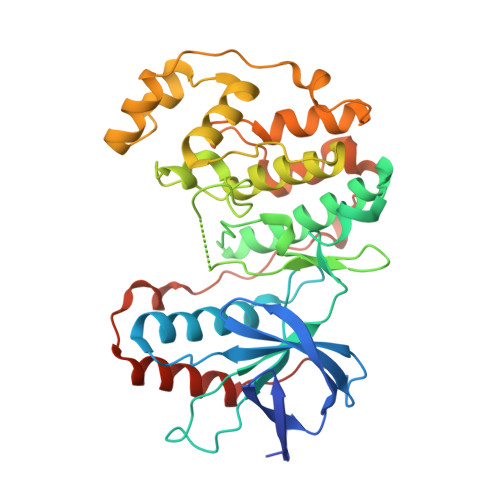Discovery and evaluation of 7-alkyl-1,5-bis-aryl-pyrazolopyridinones as highly potent, selective, and orally efficacious inhibitors of p38alpha mitogen-activated protein kinase.
Pettus, L.H., Wurz, R.P., Xu, S., Herberich, B., Henkle, B., Liu, Q., McBride, H.J., Mu, S., Plant, M.H., Saris, C.J., Sherman, L., Wong, L.M., Chmait, S., Lee, M.R., Mohr, C., Hsieh, F., Tasker, A.S.(2010) J Med Chem 53: 2973-2985
- PubMed: 20218619
- DOI: https://doi.org/10.1021/jm100095x
- Primary Citation of Related Structures:
3LHJ - PubMed Abstract:
The p38alpha mitogen-activated protein (MAP) kinase is a central signaling molecule in many proinflammatory pathways, regulating the cellular response to a multitude of external stimuli including heat, ultraviolet radiation, osmotic shock, and a variety of cytokines especially interleukin-1beta and tumor necrosis factor alpha. Thus, inhibitors of this enzyme are postulated to have significant therapeutic potential for the treatment of rheumatoid arthritis, inflammatory bowel disease, and Crohn's disease, as well as other diseases where aberrant cytokine signaling is the driver of disease. In this communication, we describe a novel class of 7-alkyl-1,5-bis-aryl-pyrazolopyridinone-based p38alpha inhibitors. In particular, compound 3f is highly potent in the enzyme and cell-based assays, selective in an Ambit kinase screen, and efficacious (ED(50) < or = 0.01 mg/kg) in the rat collagen induced arthritis (CIA) model.
- Departments of Chemistry Research and Discovery, Amgen Inc., One Amgen Center Drive, Thousand Oaks, California 91320, USA. lpettus@amgen.com
Organizational Affiliation:

















